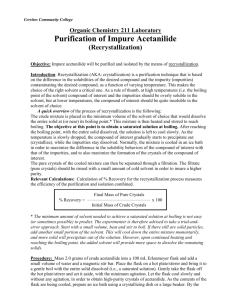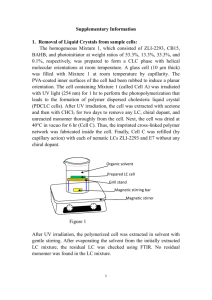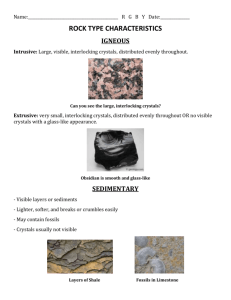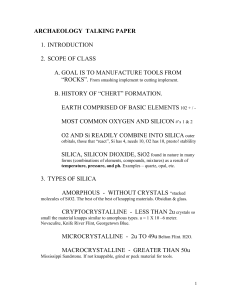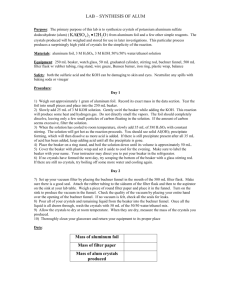MS Word - Baruch College
advertisement
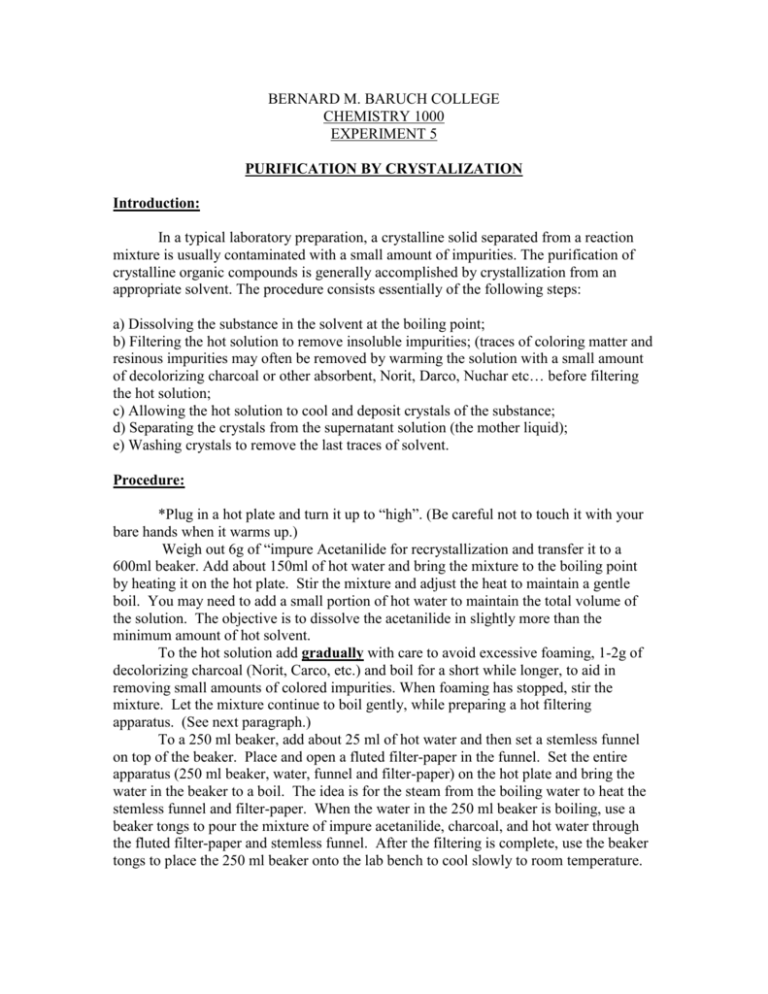
BERNARD M. BARUCH COLLEGE CHEMISTRY 1000 EXPERIMENT 5 PURIFICATION BY CRYSTALIZATION Introduction: In a typical laboratory preparation, a crystalline solid separated from a reaction mixture is usually contaminated with a small amount of impurities. The purification of crystalline organic compounds is generally accomplished by crystallization from an appropriate solvent. The procedure consists essentially of the following steps: a) Dissolving the substance in the solvent at the boiling point; b) Filtering the hot solution to remove insoluble impurities; (traces of coloring matter and resinous impurities may often be removed by warming the solution with a small amount of decolorizing charcoal or other absorbent, Norit, Darco, Nuchar etc… before filtering the hot solution; c) Allowing the hot solution to cool and deposit crystals of the substance; d) Separating the crystals from the supernatant solution (the mother liquid); e) Washing crystals to remove the last traces of solvent. Procedure: *Plug in a hot plate and turn it up to “high”. (Be careful not to touch it with your bare hands when it warms up.) Weigh out 6g of “impure Acetanilide for recrystallization and transfer it to a 600ml beaker. Add about 150ml of hot water and bring the mixture to the boiling point by heating it on the hot plate. Stir the mixture and adjust the heat to maintain a gentle boil. You may need to add a small portion of hot water to maintain the total volume of the solution. The objective is to dissolve the acetanilide in slightly more than the minimum amount of hot solvent. To the hot solution add gradually with care to avoid excessive foaming, 1-2g of decolorizing charcoal (Norit, Carco, etc.) and boil for a short while longer, to aid in removing small amounts of colored impurities. When foaming has stopped, stir the mixture. Let the mixture continue to boil gently, while preparing a hot filtering apparatus. (See next paragraph.) To a 250 ml beaker, add about 25 ml of hot water and then set a stemless funnel on top of the beaker. Place and open a fluted filter-paper in the funnel. Set the entire apparatus (250 ml beaker, water, funnel and filter-paper) on the hot plate and bring the water in the beaker to a boil. The idea is for the steam from the boiling water to heat the stemless funnel and filter-paper. When the water in the 250 ml beaker is boiling, use a beaker tongs to pour the mixture of impure acetanilide, charcoal, and hot water through the fluted filter-paper and stemless funnel. After the filtering is complete, use the beaker tongs to place the 250 ml beaker onto the lab bench to cool slowly to room temperature. The fluted filter paper with the charcoal can be discarded, the hot plate turned off, and the 600 ml beaker washed and put away. As the filtered solution cools pure acetanilide crystals (we hope) will form in the acetanilide/water mixture. To separate the acetanlide crystals from the cold water, vacuum filtration will be used. A vacuum filtration apparatus consists of a filtering flask (heavy glass Erylemeyer flask with a side-arm), Buchner funnel, rubber adapter, filter paper, and vacuum tubing. The apparatus is assembled by placing the rubber adapter on top of the filtering flask, setting the Buchner funnel on the rubber adapter, and then placing a piece of filter paper inside the Buchner funnel. The filter paper should cover all of the holes in the Buchner funnel and is sealed by pouring a small volume of water over and through the filter paper. The vacuum tubing connects the filtering flask to the laboratory bench (or fume hood) vacuum. To collect the acetanalide crystals, set up a vacuum filtering apparatus, cool the acetanlide/cold water mixture in ice water (you want the mixture to be below room temperature) turn the vacuum on, and then pour the cold acetanalide/water mixture through the Buchner funnel. Wash the actanilide crystals by shutting off the vacuum, pouring sufficient ice water into the Buchner funnel to just cover the crystals, and then turning the vacuum back on after the ice water begins to drip though the crystals. This step should be repeated three times, and the purpose of the step is to rinse the mother liquor and soluble impurities off the acetanlide crystals. After washing the acetanalide crystals, continue to draw air through the crystals in the Buchner funnel while cleaning up all other glassware or place the acetanlide crystals in a drying oven at about 60 oC. Use a weighed dry beaker for placing the crystals in the drying oven. Weigh and record the mass of the dry crystals. The purity of the acetanilide crystals can be determined by measuring the melting point range of the crystals. This can be done with melting point apparatus. All melting point apparatus consist of a hot-plate with a thermometer in the hot-plate to monitor the temperature of the hot-plate. A sample of the solid of interest is placed in a sample tube or on a sample plate and then slowly heated with the hot plate. The physical state of the sample is observed and two temperatures are recorded: 1) the temperature at which the sample begins to melt and 2) the temperature at which the sample is completely melted. The difference in temperature of these two temperature is the melting point range and the smaller the melting point range the more pure the solid. Solids with a 99 % purity have melting point ranges of less than 1 oC. Crystallization of a Non-Volatile Solute from a Solution by Evaporation of the Solvent – Invisible Salt writing. Half fill a 10ml graduated cylinder with salt solution from the stock bottle. Using a wooden splint and the salt solution, write a message on a sheet of white paper. Allow the writing to dry completely (‘till the next lab session, if necessary). When the paper is dry, scratch a soft lead pencil over the written surface. The words you have written will show up plainly in the dark lines. Experiment 5 REPORT SHEET Name________________________Lab section__________Date________________ Melting point of the “Impure Acetanilide” ________________________________ First Crystallization Second Crystallization Weight of impure Acetanilide ________________ __________________ Weight of recovered Actanilide _________________ _________________ Percent recovery of pure Acetanilide __________________ ________________ Melting point range of recovered Actanilide __________________ _________________ Questions 1) This experiment uses the separation technique of filtering. What type of mixtures can be separated using filtering? Is filtering a physical or chemical filtering technique? 2) Under what conditions is an acetanilide/water mixture a solution? a heterogeneous mixture? 3) Would you classify re-cystallization as a physical or chemical separation technique? 4) Why must the pure acetanilide be dried before weighing? before measuring the melting point? 5) What properties are necessary and desirable for a solvent in order that it be well suited for re-crystallizing a particular organic compound? 6) Why is suction filtration preferable to ordinary gravity filtration for separating the purified crystals from the mother-liquor? Why is it desirable to turn-off the vacuum before washing the crystals with small portions of fresh solvent?




